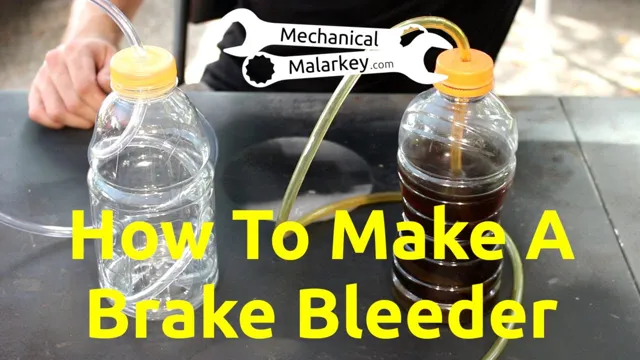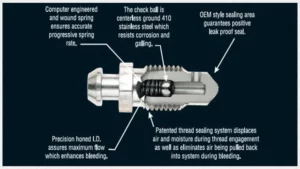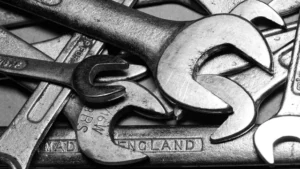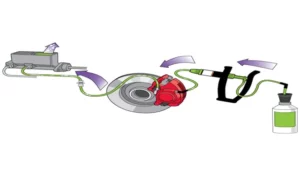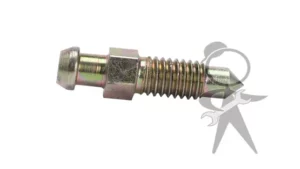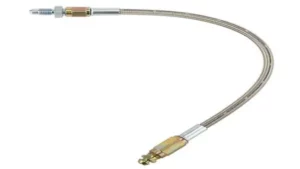Have you ever struggled with bleeding the brakes on your vehicle? It can be a frustrating and time-consuming task, especially if you don’t have a second person to help. Fortunately, there is a simple and effective solution – the one-man brake bleeder. This handy tool allows you to bleed your brakes by yourself, without the need for a helper or any complicated equipment.
But how does it work? The one-man brake bleeder is designed to create a vacuum that draws air and old brake fluid out of the brake lines, making it easier to replace with new fluid. It typically consists of a hand-held pump with a hose and a collection bottle. To use it, you simply attach the hose to the bleeder screw on your brake caliper, create a vacuum by pumping the handle, and watch as the old fluid is sucked out of the brake line.
Not only does the one-man brake bleeder save time and hassle, but it also ensures that your brakes are properly maintained for optimal performance and safety. So the next time you need to bleed your brakes, don’t sweat it – just invest in a one-man brake bleeder and get the job done quickly and efficiently.
Introduction
Have you ever wondered how a one man brake bleeder works? This handy tool revolutionizes the process of bleeding brakes, making it possible for one person to complete the task solo. The device typically includes a hand pump, a reservoir for brake fluid, and a hose with a one-way valve that attaches to the brake bleeder screw. To use the brake bleeder, you simply fill the reservoir with brake fluid, attach the hose to the bleeder screw, and pump the handle until the air bubbles stop coming out of the hose.
The one-way valve ensures that fluid only flows in one direction, preventing air from re-entering the brake system. With a one man brake bleeder, you can avoid the hassle of trying to coordinate with another person to bleed your brakes, making it a must-have tool for any DIY mechanic.
What is a One-Man Brake Bleeder?
A one-man brake bleeder is a tool used to flush out air bubbles from your brake system without needing a second person to help. It works by using a pump to create pressure in the brake reservoir, which pushes the brake fluid through your system and expels any trapped air. This is important because air bubbles in your brake lines can cause your brakes to feel spongy and unresponsive, putting you in danger on the road.
Using a one-man brake bleeder is a simple and effective way to ensure that your brake system is working properly and that you can feel confident and safe while driving. Whether you’re a professional mechanic or a DIY enthusiast, a one-man brake bleeder is an invaluable tool to have in your arsenal.
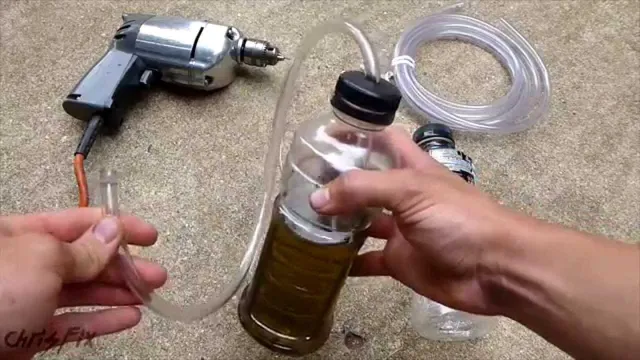
Why Use a One-Man Brake Bleeder?
One-man brake bleeders are becoming a popular choice among vehicle owners who prefer to perform their brake bleed process at home. With a one-man brake bleeder, you no longer need assistance or special tools to complete the job, making the process less tiresome and more efficient. Using a one-man brake bleeder is a straightforward process that anyone can easily learn, and it is cost-effective in the long run as it saves you money on mechanic fees.
Additionally, a one-man brake bleeder is faster than traditional brake bleeding methods, ensuring that your vehicle is ready to go in no time. With a one-man brake bleeder, you can rest assured that your brake system is well-maintained, enhancing your vehicle’s safety and performance on the road.
How the One-Man Brake Bleeder Works
Are you tired of relying on someone else to help you bleed your car’s brake system? Well, with a one-man brake bleeder, you can do it all on your own! But how does it work exactly? Essentially, the one-man brake bleeder is a small device that attaches to the brake bleeder valve. After connecting the device to the valve and opening it, you pump your brakes like you normally would, and the device takes care of the rest. As you pump the brakes, the brake fluid rushes through the system and pushes air bubbles out of the valve, which are then captured by the one-man brake bleeder.
This process continues until all the air is removed from the brake system, and then you’re left with fully functioning brakes. The availability of such handy and practical tools like the one-man brake bleeder has made brake bleeding a one-person job, a much-needed relief for any car owner keen on doing the work themselves.
Preparing the Brake Fluid
When it comes to preparing brake fluid for use with a one-man brake bleeder, there are a few important steps you need to take. First, make sure you have the right type of brake fluid for your vehicle. Check your owner’s manual or with a trusted mechanic to find out which type of fluid is recommended.
Next, remove the existing brake fluid from the brake fluid reservoir using a turkey baster or similar tool. Be sure to discard the old fluid properly. Then, fill the reservoir with fresh brake fluid up to the recommended level.
It’s important to note that brake fluid can absorb moisture from the air, so it’s best to only open a new bottle when ready to use it. By following these steps and using the correct brake fluid, you can ensure that your one-man brake bleeder works efficiently and effectively.
Attaching the Bleeder Hose
Attaching the bleeder hose is a crucial step in using the one-man brake bleeder. The bleeder hose is the key component that transports the old brake fluid out of the brake caliper into a receptacle. To ensure proper attachment, locate the bleeder screw on the brake caliper and unscrew it with the appropriate wrench.
Then, attach the bleeder hose to the screw and secure it tightly. Next, place the other end of the hose into a container for the old brake fluid to drain into. With the bleeder hose properly secured, you can now begin the brake bleeding process.
It is important to check that the hose is not kinked or obstructed to ensure the brake fluid can flow freely. By following these simple steps, you can effectively use the one-man brake bleeder to replace old brake fluid with new, clean fluid and improve your vehicle’s braking performance.
Pumping the Brake Pedal
If you’re a car enthusiast or just want to save yourself some money, then you may know how important it is to bleed your brakes. While there are different methods to get the job done, using the one-man brake bleeder stands out as an effective and straightforward solution. This handy gadget utilizes the force created by the brake pedal to push air bubbles out of the brake lines, making your brakes more efficient.
To use it, you need to attach the bleeder to the brake caliper’s bleeder valve, pump the brake pedal a few times, and watch as the dirty fluid disappears, indicating that the air has been purged. The one-man brake bleeder is a must-have tool for anyone who wants to maintain their brake system’s efficiency without breaking the bank.
Tips and Tricks for Using a One-Man Brake Bleeder
How does a one-man brake bleeder work? This tool comes in handy when you need to bleed your brakes alone without any assistance. The one-man brake bleeder has a hand-held pump mechanism that creates a vacuum in the brake system. It sucks out any air and brake fluid that may be in the brake lines.
Also, it has a clear hose that connects to the brake bleeder valve, allowing you to observe the brake fluid as it comes out. You start by emptying the old brake fluid from the master cylinder, and then pump the bleeder until you see no air bubbles in the clear hose. To keep the brake fluid in the master cylinder, you need to keep an eye on its level and refill it as necessary.
The one-man brake bleeder saves you time and hassle by allowing you to do your brake bleeding by yourself without any external help. It is an essential tool for any DIY mechanic who wants to work on their brakes alone.
Check for Leaks
One of the most important things to keep in mind when using a one-man brake bleeder is to check for leaks. Leaks can happen anywhere along the brake line, so it’s important to carefully inspect all components. Start by examining the master cylinder for signs of leaks, such as fluid pooling around the base of the reservoir.
Next, check the brake lines for cracks or signs of damage that could cause fluid to leak out. Finally, check the bleeder valve itself to make sure it’s properly secured and not emitting any fluid. Remember, even a small leak can cause air to enter the system, making it difficult to properly bleed your brakes.
So take the time to carefully inspect all components before proceeding with the bleeding process.
Keep an Eye on Brake Fluid Level
Brake fluid is an important component of any braking system and should always be checked regularly to ensure that it is at the correct levels. A one-man brake bleeder can be an incredibly useful tool to use for this purpose. These devices help to make the process of bleeding brakes much easier.
If you are using a one-man brake bleeder, it is essential to keep an eye on the brake fluid level at all times. This will prevent air from entering the brake system, which can cause problems with the brakes. Remember to top up the brake fluid regularly, as running low on brake fluid can also cause damage to the brakes.
The key to keeping your brakes in top condition is to be proactive and stay on top of brake maintenance. By taking care of your braking system and checking your brake fluid regularly, you can be sure that you are driving safely and responsibly on the road.
Bleed Brakes in Correct Order
If you’re looking to bleed your brakes yourself, using a one-man brake bleeder can make the task much easier. However, it’s important to remember to bleed the brakes in the correct order to avoid air pockets and ensure proper braking. Start with the wheel farthest from the master cylinder and work your way towards it, typically starting with the right rear, left rear, right front, and ending with the left front.
Make sure to keep an eye on the brake fluid level during the bleeding process and refill as necessary to prevent air from entering the system. Using a one-man brake bleeder can be a helpful tool, but it’s always a good idea to double-check your work and have a professional mechanic inspect the brakes before hitting the road. Make safety your top priority and stay on top of brake maintenance to ensure reliable stopping power when you need it most.
Conclusion
In conclusion, a one man brake bleeder is like having your own personal air traffic controller for your car’s brake system. By creating a vacuum effect, it easily removes any air bubbles within the brake lines – allowing you to take control of your vehicle’s stopping power. So go ahead and give your brakes the attention they deserve, with a one man brake bleeder that is as easy to use as it is effective.
Just remember to leave the witty puns to us!”
FAQs
What is a one man brake bleeder?
A one man brake bleeder is a tool used by a single person to bleed their brake system without requiring a second person to operate the brake pedal.
How does a one man brake bleeder work?
A one man brake bleeder works by using vacuum pressure to pull brake fluid through the brake lines and expel any air bubbles, thus ensuring proper brake function.
Is it easy to use a one man brake bleeder?
Yes, a one man brake bleeder is designed to be easy to use. Simply connect it to your brake system, create vacuum pressure, and begin the brake bleeding process.
Can a one man brake bleeder be used on all types of vehicles?
Yes, a one man brake bleeder can be used on all types of vehicles that have hydraulic brake systems, including cars, trucks, and motorcycles.
Can a one man brake bleeder save time?
Yes, a one man brake bleeder can save a significant amount of time compared to traditional brake bleeding methods that require a second person’s help.
Is a one man brake bleeder affordable?
Yes, a one man brake bleeder is an affordable tool that can save you money by allowing you to perform brake maintenance at home without the need for a mechanic.
Is a one man brake bleeder durable?
Yes, a one man brake bleeder is typically made from high-quality materials that are designed to withstand frequent use and last for years.
